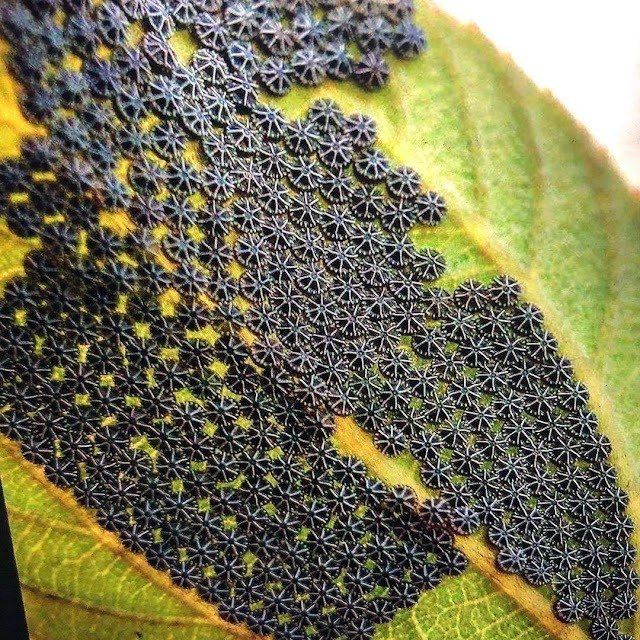One of life’s greatest pleasures is tending a garden. Whether it’s a lush flower bed or a vegetable garden, there is something incredibly fulfilling about watching your plants grow and thrive. The joy of seeing your hard work rewarded, whether in the form of blooming flowers or fresh produce, is unparalleled. However, the road to a flourishing garden is not always smooth, and it comes with its own set of challenges. One of the most persistent issues gardeners face is dealing with pests. Identifying the good bugs from the bad can sometimes be a challenge, and even the most well-kept gardens are not immune to infestations.
As I was scrolling through social media the other day, I came across an intriguing photograph that caught my attention. It showed a leaf covered in small, intricate black geometric designs. At first glance, it looked like something out of a science fiction movie—a mysterious alien pattern or perhaps a plant disease. I couldn’t help but feel a pang of concern, as many others likely did upon seeing the image. However, as I looked more closely, the truth slowly revealed itself. What I initially thought were strange markings turned out to be the eggs of a butterfly species—specifically, the Nymphalis Antiopa, commonly known as the Mourning Cloak butterfly.
The Magical Mourning Cloak Butterfly
In case you’re unfamiliar with the Mourning Cloak butterfly, let me introduce you to this fascinating creature. The Mourning Cloak is not just any butterfly—it’s a remarkable species with an incredible life cycle and a number of unique characteristics that make it an ecological wonder. The eggs that adorned the leaf in the photo I saw are the beginning of this butterfly’s life cycle. What appeared to be a delicate black lace pattern is actually a cluster of eggs carefully deposited on the surface of the leaf.
Upon further inspection, these eggs reveal their unexpected beauty. Their intricate geometric patterns showcase the perfect symmetry found in nature. It’s easy to be captivated by their design, and although many gardeners might initially feel a sense of dread when encountering such eggs on their plants, the truth is that they may be doing more good than harm.
Ally or Enemy? Why Mourning Cloak Butterflies Are Beneficial
If you are a gardener, you might worry that the caterpillars of the Mourning Cloak butterfly will wreak havoc on your precious plants. It’s understandable to be cautious, especially when the caterpillars look like they could devour everything in sight. However, there is no need to panic. The Mourning Cloak caterpillars primarily feed on trees like willows, elms, and poplars, so they are unlikely to cause significant damage to your flower beds or vegetable garden. In fact, they actually play a vital role in the ecosystem.
The larvae of the Mourning Cloak butterfly help break down rotting fruit, aiding in the process of decomposition. This natural recycling process is an important part of maintaining a healthy garden ecosystem, as it helps return valuable nutrients to the soil. So, rather than viewing these butterflies as pests, it’s better to think of them as little helpers who assist in the greater balance of nature.
Hibernation and Its Symbolic Significance
One of the most fascinating aspects of the Mourning Cloak butterfly is its unique hibernation habits. While most butterflies follow a more typical wintering process, the Mourning Cloak takes an entirely different approach. As the temperatures begin to drop, these butterflies don’t migrate or retreat to a traditional hibernation site. Instead, they seek shelter in hidden spots like sheds, loose bark, or even woodpiles. When spring arrives, they are often among the first insects to emerge from hibernation, making their appearance even before flowers begin to bloom.
The name “Mourning Cloak” comes from the butterfly’s distinctive black wings, which resemble the cloak worn during mourning or funerary rituals. This symbolism is tied to the butterfly’s early arrival in spring, as it represents the rebirth and renewal of life after the harsh winter months. It’s a beautiful reminder of the cyclical nature of life and the important role that these creatures play in our gardens.
Maintaining a Harmonious Garden Ecosystem
When it comes to gardening, one of the most important lessons we can learn is the value of balance. As gardeners, we often focus on the plants we care for—nurturing them, tending to their needs, and protecting them from pests. However, we also need to remember that our gardens are home to a wide variety of creatures, each playing an essential role in the ecosystem. The Mourning Cloak butterfly is a perfect example of this delicate balance in nature.
Many gardeners might be inclined to remove or destroy the eggs of the Mourning Cloak butterfly upon seeing them on their plants, fearing the potential damage the caterpillars might cause. However, by taking a step back and considering the bigger picture, we can see that these butterflies are not the enemy. Instead of viewing them as pests, we should embrace them as allies in maintaining a healthy, balanced garden.
In fact, when we create a welcoming environment for these butterflies, we are contributing to the overall health of the garden ecosystem. By allowing the Mourning Cloak caterpillars to feed on trees like willows and poplars, we are supporting the process of decomposition and nutrient recycling. This is an important part of keeping the soil healthy and fertile, which in turn benefits the plants we care about.
What Should You Do If You Find These Eggs on Your Plants?
If you discover the eggs of the Mourning Cloak butterfly on your plants, the best course of action is to leave them alone. These eggs will eventually hatch into caterpillars, which will feed on trees rather than the plants in your garden. In fact, it’s a good idea to embrace the process and allow nature to take its course. The caterpillars will eventually turn into beautiful butterflies that will continue the cycle of life in your garden.
If you feel concerned about the proximity of the caterpillars to your valued plants, you can gently relocate them to a nearby tree or shrub. This will allow them to continue their life cycle without interfering with your flowers or vegetables. Remember, the goal is to maintain a harmonious balance in your garden, where both plants and insects can coexist peacefully.
Harmony and Exploration: The Gardening Key
Gardening is about more than just planting flowers and harvesting vegetables—it’s about exploring the intricate web of life that exists within our gardens. By being open to the idea that not all insects are harmful, we can cultivate a more diverse and resilient ecosystem. Before reaching for pesticides or attempting to remove any creature you find in your garden, take the time to observe and explore. You may be surprised by what you discover.
As I learned from my encounter with the Mourning Cloak butterfly eggs, sometimes what seems like an unusual or even alarming sight in your garden can be a beautiful and beneficial part of the ecosystem. By embracing these natural wonders and allowing them to thrive, you contribute to a garden that is not only healthy and thriving but also full of life and biodiversity.
The Final Takeaway
Gardening is a rewarding and enriching activity that allows us to connect with nature in a meaningful way. However, it also comes with its challenges. When we encounter something unusual, like the eggs of the Mourning Cloak butterfly, it’s important to step back and assess the situation with an open mind. By understanding the role that insects like the Mourning Cloak butterfly play in our gardens, we can foster a more balanced and harmonious environment for all living things.
Next time you spot these fascinating eggs on your plants, don’t reach for the pesticide or try to remove them. Instead, take a moment to appreciate the beauty and complexity of nature. Leave the eggs where they are, and embrace the journey of transformation that will take place right before your eyes. Your garden will thank you for it.





